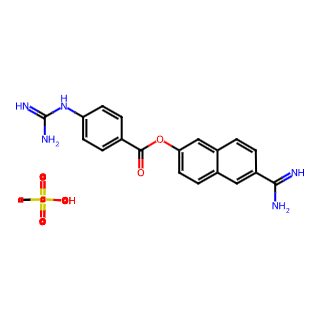- Synthetic anti-infective drugs
- Medications for the digestive system
- Antipyretic and analgesic drugs
- Medications for the blood system
- Medications for the respiratory system
- Anti-allergic drugs
- Medications for the urinary system
- Diagnostic medications
- Immunosuppressive and immunomodulatory drugs
- Vitamins and mineral supplements
- Antioxidants and medications for osteoporosis
- Antiparasitic drugs
- Ophthalmic medications
- Amino acids and their derivatives
- Dermatological medications
- Medications for the circulatory system
- Antitumor drugs
- Medications for the nervous system
- Hormonal and endocrine function-regulating drugs
- Antibiotics
- Others
CAS NO.: 82956-11-4




Nafamostat Mesylate
Nafamostat Mesylate is a broad-spectrum serine protease inhibitor with diverse pharmacological effects and extensive clinical applications.
Basic Information
English Name: Nafamostat Mesylate
CAS Number: 82956-11-4
Molecular Formula: C21H25N5O8S2 (Note: Depending on the source, the formula may also be represented as C19H17N5O2·2CH4O3S, accounting for the mesylate salt)
Molecular Weight: 539.58
Appearance: Yellowish-brown to light orange solid or white to off-white crystalline powder
Storage Conditions: Store in a cool, dry place with good ventilation. Optimal storage temperature is 4°C, with -4°C being even more preferable.
Physical and Chemical Properties
Melting Point: 258°C to 261°C
Boiling Point: 637.2°C at 760 mmHg
Flash Point: 339.1°C
Solubility in Water: Soluble; slightly soluble in ethanol and methanol; insoluble in ether and acetone
Pharmacological Effects
Anticoagulant Effect: Inhibits the activity of thrombin, factor VIIa, factor XIIa, and factor Xa, thereby exerting an anticoagulant effect.
Antifibrinolytic Effect: Binds to fibrinolytic enzymes, prolonging fibrinolysis time.
Antiplatelet Effect: Inhibits platelet aggregation and promotes disaggregation of aggregated platelets.
Inhibition of Trypsin: Inhibits both free trypsin and trypsin bound to α2-macroglobulin, as well as phospholipase A2.
Other Effects: Inhibits the kallikrein-kinin system and complement system.
Clinical Applications
Initially used for the treatment of acute pancreatitis, Nafamostat Mesylate is now widely applied in anticoagulation during extracorporeal circulation for blood purification procedures, such as continuous renal replacement therapy (CRRT), intermittent hemodialysis, hemofiltration, and hybrid modes combining multiple techniques.
Due to its short half-life (5-8 minutes), it has minimal impact on systemic coagulation function, making it particularly suitable for patients with bleeding risks or active bleeding.

Tai Yau Street, San Po Kong, Kowloon, Hong Kong, China.



